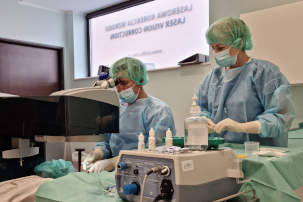
Laser vision correction – an SBK LASIK method |
| 12-04-2022 |
 A laser vision correction surgery allows to correct refractive errors, such as short-sightedness (up to -14D), far-sightedness (up to +6D) and astigmatism (up to 6D) as well as their various combinations.
A laser vision correction surgery allows to correct refractive errors, such as short-sightedness (up to -14D), far-sightedness (up to +6D) and astigmatism (up to 6D) as well as their various combinations.
To increase the chances of positive qualification for the surgery, various correction methods, i.e. ways of preparing the cornea for laser treatment, have been designed. This enables patients with thinner cornea or more severe refractive error to enjoy perfect visual acuity without glasses or contact lenses. Laser vision correction with the use of the superficial method additionally opens the door to a career in uniformed services or sport.
SBK LASIK is a less invasive form of LASIK. During the procedure, an ophthalmic surgeon uses a microkeratome to separate a thin corneal epithelial flap (approximately 100 micrometres) and thus get access to the area below the surface of Bowman’s membrane of the cornea.
Once the cornea is remodelled with an excimer laser, the corneal flap returns to its original position, where it spontaneously attaches to the rest of the cornea and heals, thus not causing any pain after the procedure.
This method is suitable for patients who would like to quickly return to their everyday routine. It is advised to all those who are not at risk of injuries, with an appropriate thickness of the cornea. It is perfect for correcting high values of vision defects.
Possible sensations immediately after the surgery
Directly after the procedure, the patient may experience slight discomfort in the form of eye dryness or lacrimation and slightly blurry vision. These symptoms usually do not last longer than 2-3 days.
Depending on each patient's corrected defect and individual predispositions, the recovery process may look slightly different.
After the SBK LASIK surgery, convalescence is much faster than in the case of other methods, TransPRK (StreamLight) or LASEK, and usually lasts up to 3-5 days.
Regardless of the method, we assume that the corneal healing process takes approximately a month, which is why it is necessary to avoid staying in dusty and smoky rooms, bathing in water reservoirs (swimming pool, sea), and using a sauna.
Physical exercise involving heavy lifting and sudden movements which may lead to increased intraocular pressure should be limited for about a month.
Patients sometimes experience symptoms connected with the way they see light, such as circles around light sources. It is a symptom typical of the corneal healing process, which usually disappears within a few weeks or up to six months.
It is also worth mentioning that the adaptation of close-range vision is a slower process than the adaptation of distance vision, taking even up to a month. The higher the corrected refractive error, the longer the time required to regain full close-range visual acuity.
In case of an SBK LASIK surgery, a follow-up appointment is scheduled for the next day after the procedure.
There is a noticeable improvement in vision almost immediately after the surgery, and the eyesight keeps improving further day by day. Most patients achieve acute vision within the first few hours following the procedure. However, full visual stability with the desired correction result obtained may take from a few weeks to even half a year, depending on the value of the corrected defect and on how well the patient follows the post-operative guidelines.